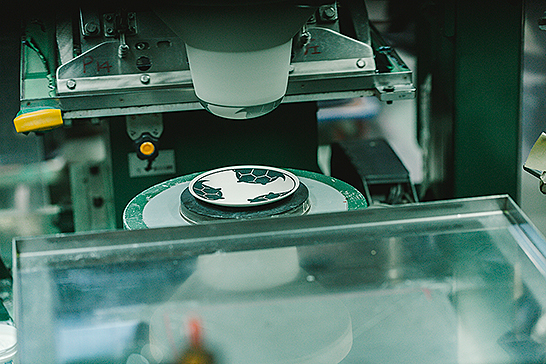小田焼は1921年、岐阜県東部の美濃焼産地、瑞浪市で創業しました。この地域は、近隣の多治見市や土岐市とともに、日本有数の陶磁器産地の一つ、美濃焼地域として栄えました。
小田焼のある瑞浪は、明治初期から欧米諸国向けの洋食器を生産・輸出し、世界有数の白磁産地として栄えてきました。先人たちの技と想いは脈々と受け継がれ、小田焼では約100年にわたり白磁を作り続けています。
小田焼の最大の強みは、他メーカーには真似できない「完璧な白」の磁器を創り出す技術にあります。白磁の魅力と品質、そして技術を融合させ、現代の暮らしに寄り添う、日本発の新時代の白磁器椀を提案します。これからも高品質な製品を世界各国へお届けしていきたいと考えています。
Yunomiより:小田陶器さんの和をテーマにした商品のみをカタログに追加する予定ですが、他にご要望があればお知らせください。



技術
小田焼は、難易度と完成度の高い食器を専門に製造しています。特に白磁の色、形、厚みなど、他の追随を許さない完成度を誇りとしています。特に素材の持ち味を最大限に引き出す技術には自信を持っています。日々、高品質な製品を作り続ける中で、品質の維持・向上を常に意識しています。お客様のご要望に合わせて、形状やデザインなど、あらゆるご要望にきめ細やかにお応えするため、以下の方法を駆使しています。






成形方法
ローラーマシン
これは素地を成形する方法です。高速回転する金属ローラーで素地を型に押し込み、型に流し込みます。この方法は主に、皿、椀、カップなどの回転体の大量生産に用いられます。当社では7台の成形機を保有しており、1台あたり1日約3000個の生産能力があります。このような大量生産には、機械の初期費用は必要ですが、大量生産によって1個あたりの価格は下がります。
圧力鋳造
これは圧力を用いて素地を成形する方法です。圧力をかけながら、泥状の素地を石膏型に流し込みます。素地から水分が完全に抜けて固まったら、型から取り出します。この技法は、両面にレリーフを施した製品や、真円ではない異形品、ローラー成形機では成形できない製品の量産に最適です。この技法にも投資と石膏型の費用は必要ですが、ローラー成形機よりも生産コストを抑えることが可能です。
デコレーション方法
パッド印刷
シリコンパッドを用いた印刷方法です。印刷済みの非光沢版をシリコンパッドの下に移動させます。シリコンパッドを版に押し付けることで、デザインが製品に転写されます。シリコンパッドは非常に柔らかいため、製品の曲面に沿って印刷できます。製品の凹部を増減させることで、印刷にグラデーションを加えることも可能です。この方法では最大3色まで使用できます。この機械は高速かつ効率的な印刷が可能であるため、大量生産に適しています。
スクリーン印刷
このプリント方法では、曲面にも簡単に模様やデザインを転写できます。シルクメッシュを用いて、模様やデザインを布地に塗布し、製品に貼り付けます。この方法は、カップなどの回転体製品へのプリントに最適です。この機械は、このプリント方法を迅速かつ効率的に大量生産できる方法です。
銅デカール
この技法では、まず銅版の上に和紙を敷き、そこに模様を刻みます。すると銅版の素材の一部が和紙に転写され、それを粘土に貼り付けます。また、接合部を一つ一つ接着することで、スクリーン印刷以上の表現が可能になります。傷や歪み、シワといった表情が、この技法の温かみを一層引き立てます。

デカール
この技法では、すでに釉薬をかけた製品に模様やデザインを施すことが可能です。再焼成することで、模様やデザインが製品に定着します。そのため、様々な色を使ったデザインの選択肢が広がります。釉薬に模様を付ける方法と、釉薬に模様を沈み込ませる方法があります。お客様のデザインとご予算に合わせて、最適な方法をご提案いたします。
グレージング
釉薬を掛ける「グレージング」は、製品に強度と光沢を与えます。釉薬を塗り、1300度の高温で焼き上げます。この「グレージング」という工程は非常に難しく、製品全体に均一な釉薬の層を保つには高度な技術と職人技が求められます。釉薬は色、質感、表情のバリエーションが無限大です。何度も試作を重ねることで、お客様のイメージにぴったりの釉薬を開発することが可能です。
私たちの作品
小田陶器は1921年の創業以来、数々の国内・有名ブランドのOEM製品を手掛けてきました。約100年の経験を基に、2004年より作り始めたオリジナル製品は、欧米をはじめ世界各地へ輸出され、世界中で評価されています。インテリアライフスタイルショーをはじめとする国内展示会をはじめ、ドイツのアンビエンテ、フランスのメゾン・オブジェ、香港のハウスウェアショーなど、海外展示会にも積極的に出展しています。

ほのか
このシリーズは、ローラーマシンの特性を活かして開発されました。レリーフ部分のみ生地を薄くすることで、光が当たると白磁の上で優しく輝き、様々な模様が繊細に浮かび上がります。ミニサイズのロックはキャンドルホルダーとしても最適です。

櫛目
繊細な線が釉薬と滑らかに調和し、和の風情を醸し出す、和モダンスタイルのシリーズです。

シェル
スプーンですくいやすさを考慮し、洗練された貝殻のモチーフをあしらったデザイン。時代を超えて愛される、誰からも愛されるデザインだと感じています。

てっぱち
この意匠は古くから日本料理に用いられてきました。椀の縁が内側にカーブしているため、食材を優しく加熱調理することができます。また、生け花にも用いられます。

縁起紋
松、竹、梅、鶴、亀といった日本の伝統的な美しい模様は、縁起が良いとされています。また、日本の家紋の影響も受けています。

旅籠
日本の伝統的な文様を、使いやすさを追求したフォルムに再設計。「おもてなし」という日本の現代的なおもてなしの心を表現しています。